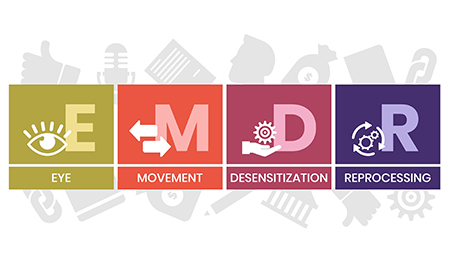 Traumatic memories can keep coming back.
Traumatic memories can keep coming back.
The human brain is amazing. “Normal” memories become filed very orderly and methodically, kinda like a library card catalog. (And, yes, I’m dating myself!)
Trauma memories, however, are thrown together like a tapestry with threads touching other memories. These threads of memories are why seemingly minor details can so easily trigger one.
When those memories trigger trauma, the right side of the brain is on fire as the seat of emotion takes over. As a result, the right side runs rampant over logic (the left side).
When emotions overtake logic, it becomes hard to think straight or speak well when triggered.
 How does EMDR work?
How does EMDR work?
EMDR uses bilateral stimulation (left and right hemispheres of the brain) to bring up both sides of the brain, assisting them to work together to reprocess those traumatic memories. (Ask me for a demonstration!)
Who is a good candidate for EMDR? Any person adversely affected by trauma is a good candidate.
Trauma comes in many forms; some are complex, and some result from a single incident.
Some complex traumas can result from childhood experiences and continue through adulthood. Causes of complex trauma may be the result of sexual or physical abuse.
Single-incident traumatic events, such as a car accident or anything in between, can have a lasting effect, keeping you on guard for the event to happen again. The ability to recall visual imagery is helpful.
What does EMDR therapy look like?
I will assist you in creating a trauma memory list. Our work will start with more accessible stuff and progress to harder, more difficult memories as you develop tolerance and capability. With the memory called up, no talking is necessary for the processing.
Historically, therapists used eye movements to help clients process, such as tracking the therapist’s hand movements. Light bars made a therapist’s life much easier. Tapping, such as on one’s knees, can also be utilized. I use Theratappers, small units held in each hand, emitting alternating vibrations (customizable).
The overall process is painless! I check in periodically to see how you are doing and where we are with the processing. Work is done in this manner until you metabolize the memory. I assist you with coping strategies to enable you to stay with the memory until the achievement of this metabolization.
 Come on – Does this EMDR work?
Come on – Does this EMDR work?
YES! As part of my training, I underwent EMDR myself. I experienced an event that constantly caused me mental and physical anguish. After one session, I could walk away feeling that the event was a sad event that I had no control over, and I could let it go.
I have witnessed clients “let go” of their traumas. The number of sessions required depended on the severity of the trauma – the release of the trauma brought about the cessation of nightmares and flashbacks, hypervigilance, and other symptoms.
Clients reported feeling sad about the events that happened to them but no longer plagued or held back by them.
EMDR Intensives
 What is it?
What is it?
Regular EMDR sessions are 50-75 minutes. However, I offer intensives for motivated clients wishing to work through their trauma faster and can spare 2-3 hours, depending on the client’s out-of-session work and tolerance for the process. Insurance benefits may not cover this service.
Stop letting your TRAUMA or trauma run your life! Now is the time to take control! Call TODAY for your 20-minute consultation – (360) 620-4928.
Let’s see if we’re a good fit!
